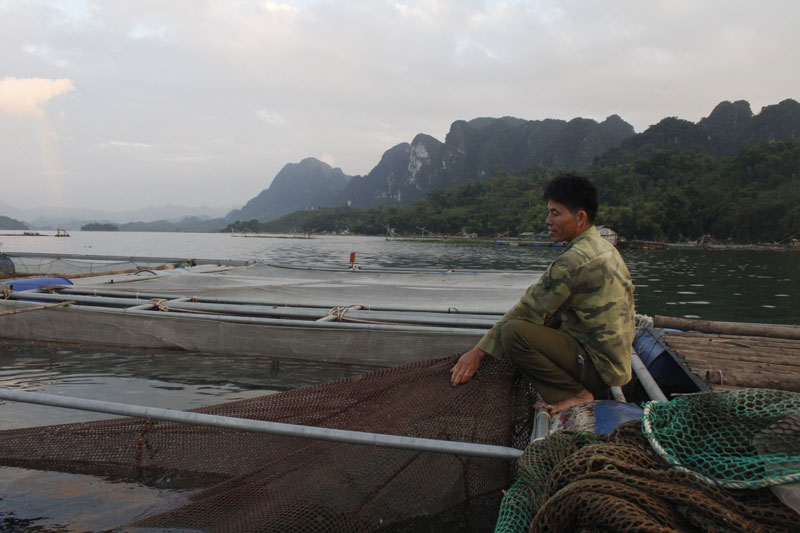
(HBO) - For 2 years, 91 households in Ngoi village, Ngoi Hoa commune, Tan Lac district have been known as doing community - based tourism. To attract tourists, many households have invested in infrastructure and repairing houses, preparing costumes, etc. according to local customs and practices. From community tourism, many households have a stable source of income. However, to attract tourists to the locality, Mr. Bui Van Chien's family - a household in the village chose his own way of raising specialty fish to serve tourists.

Mr. Bui Van Chien in Ngoi village, Ngoi Hoa
commune, Tan Lac district raises hemibagrus fish, creates a tourist product on
the lake to attract tourists.
Mr. Chien said: This house was built with the
capital of over 200 million VND from fish profit. Due to the edge of the river,
it was airy and spacy but cost more than elsewhere, it was needed to build
stone embankments to avoid landslides. like many families in this lake area, my
family has to "resettle" many times to live in Ngoi village as now.
Many years ago, being supported by the State, I planted 5,000 m2 of some kinds
of bamboos like bương and luồng to collect young bamboo shoots and collecting trees. At the
end of the harvest, we went to the river to catch fish with nets and dropped
shrimp nets. In those years, fish and shrimp were so much, we could catch
hundredweight of fish and shrimps.
Mr. Chien said: In recent years, more people
have caught seafood. They even use electricity to catch and with the level of
destroying, therefore, the quantity of shrimp and fish is becoming less and
less. Prior to the fact that the aquatic resources has been increasingly
exhausted, he and his neighbors in the village have made fish cages for raising
fish. At first, each house had only 2-3 cages raising traditional fish
varieties such as black and white amurs. These two fish varieties are suitable
for natural conditions on the lake bed, so they are less sick and the caring
duty is not difficult. Seeing the economic efficiency, he made more cages with
larger scale. According to Mr. Chien, the food source of these two types of
fish is plentiful. The farmers mainly have to spend their working labor with
little investment, so their income is more than planting some kinds of bamboos
like bương and luồng or
growing maize or cassava. In May 2017, the Poverty Reduction Project and
Program 135 invested in net cages and iron frames for households raising fish
in the lake, he was supported to invest in 7 cages. After making the cages, he
raised black and yellow hemibagrus fish with more than 1,000 fish. This is a
special fish with high economic value in the lake area, so it is preferred by
customers. For those fish being at 4-5 kg or more, the price is very high.
Due to lack of technique, in the watery season, the fish-water turbulence was
abdicated and died. For the fear of disease, in June, 2018, he sold all fish
and continued to invest in expanding fish farming. With a little experience,
this year, he invested in a few thousand fish breeding in 5 cages and released
into many different groups.
In the first 9 months of 2024, Hoa Binh province continues to implement the expanded tourism development cooperation program plan of 8 Northwest provinces with Ho Chi Minh City; deploying digital transformation content in tourism and developing a smart tourism province. Hoa Binh province received about 3.6 million views, an increase of 7.9% over the same period. In which, international visitors are about 380 visitors, domestic visitors are estimated at 3 million 220 visitors.
Spanning thousands of hectares and winding gracefully along mountain slopes, hillsides, and riverbanks, the terraced rice fields of Lac Son District present a stunning and captivating beauty. This region, renowned for its remarkable terraced landscapes, is also the centre of Hoa Binh Culture known for numerous archaeological sites.
The life of Mong people in Hang Kia and Pa Co communes of Mai Chau district has improved much thanks to tourism development.
The man-made Hoa Binh Lake, with a water surface area of approximately 9,000 hectares and a capacity of 9.45 billion cubic meters, stretches over 200 kilometers from Hoa Binh to Son La provinces. With the goal of developing into a national tourism area, the Hoa Binh Lake tourism area is expected to not only become the largest tourism centre in the province but also one of the 12 key tourist destinations in the northern midland and mountainous region of Vietnam.
Da Bia hamlet, now Duc Phong, in Tien Phong commune, Da Bac district, was once almost isolated from the outside as the only way to the hamlet was to get a boat ride across the Hoa Binh reservoir. However, as its tourism potential has been unleashed, the hamlet has established itself as one of the most attractive destinations on the tourism map. It has even received the ASEAN Community-Based Tourism Awards in 2019.
In the first 9 months of 2024, Mai Chau district, Hoa Binh province welcomed over 684 thousand visitors to visit and relax. In which, over 516 thousand domestic visitors and more than 168 thousand international visitors. Total revenue from tourism is estimated at over 821 billion VND.



